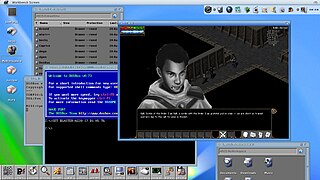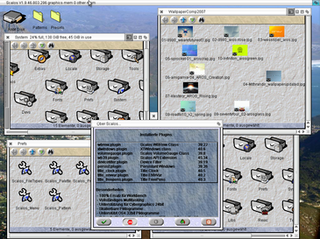Related Research Articles
AmigaGuide is a hypertext document file format designed for the Amiga. Files are stored in ASCII so it is possible to read and edit a file without the need for special software.
AmigaDOS is the disk operating system of the AmigaOS, which includes file systems, file and directory manipulation, the command-line interface, and file redirection.
In the Unix operating system, shar is an archive format created with the Unix shar utility. A shar file is a type of self-extracting archive, because it is a valid shell script, and executing it will recreate the files. To extract the files, only the standard Unix Bourne shell sh is usually required.
MorphOS is an AmigaOS-like computer operating system (OS). It is a mixed proprietary and open source OS produced for the Pegasos PowerPC (PPC) processor based computer, PowerUP accelerator equipped Amiga computers, and a series of Freescale development boards that use the Genesi firmware, including the Efika and mobileGT. Since MorphOS 2.4, Apple's Mac mini G4 is supported as well, and with the release of MorphOS 2.5 and MorphOS 2.6 the eMac and Power Mac G4 models are respectively supported. The release of MorphOS 3.2 added limited support for Power Mac G5. The core, based on the Quark microkernel, is proprietary, although several libraries and other parts are open source, such as the Ambient desktop.

GNU Wget is a computer program that retrieves content from web servers. It is part of the GNU Project. Its name derives from "World Wide Web" and "get". It supports downloading via HTTP, HTTPS, and FTP.

The Magic User Interface is an object-oriented system by Stefan Stuntz to generate and maintain graphical user interfaces. With the aid of a preferences program, the user of an application has the ability to customize the system according to personal taste.

Elvis is an enhanced clone of the vi text editor, first released in January 1990. It introduced several new features, including syntax highlighting and built-in support for viewing nroff and HTML documents. Elvis is written by Steve Kirkendall and is distributed under the Clarified Artistic License (ClArtistic) which is used by Perl and is a GPL-compatible free software license.
Amiga software is computer software engineered to run on the Amiga personal computer. Amiga software covers many applications, including productivity, digital art, games, commercial, freeware and hobbyist products. The market was active in the late 1980s and early 1990s but then dwindled. Most Amiga products were originally created directly for the Amiga computer, and were not ported from other platforms.

AROS Research Operating System is a free and open-source multi media centric implementation of the AmigaOS 3.1 application programming interface (API). Designed to be portable and flexible. As of 2021, ports are available for personal computers (PCs) based on x86 and PowerPC, in native and hosted flavors, with other architectures in development. In a show of full circle development, AROS has been ported to the Motorola 68000 series (m68k) based Amiga 1200, and there is also an ARM port for the Raspberry Pi series.
Hunk is the executable file format of tools and programs of the Amiga Operating System based on Motorola 68000 CPU and other processors of the same family. The file format was originally defined by MetaComCo. as part of TRIPOS, which formed the basis for AmigaDOS. This kind of executable got its name from the fact that the software programmed on Amiga is divided in its internal structure into many pieces called hunks, in which every portion could contain either code or data.
Amiga support and maintenance software performs service functions such as formatting media for a specific filesystem, diagnosing failures that occur on formatted media, data recovery after media failure, and installation of new software for the Amiga family of personal computers—as opposed to application software, which performs business, education, and recreation functions.
AHI is a retargetable audio subsystem for AmigaOS, MorphOS and AROS. It was created by Martin Blom in the mid-1990s to allow standardized operating system support for audio hardware other than just the native Amiga sound chip, for example 16-bit sound cards.
Commodore Amiga MIDI Driver (CAMD) is a shared library for AmigaOS which provides a general device driver for MIDI data, so that applications can share MIDI data with each other in real-time, and interface to MIDI hardware in a device-independent way.

AmigaOS is a family of proprietary native operating systems of the Amiga and AmigaOne personal computers. It was developed first by Commodore International and introduced with the launch of the first Amiga, the Amiga 1000, in 1985. Early versions of AmigaOS required the Motorola 68000 series of 16-bit and 32-bit microprocessors. Later versions were developed by Haage & Partner and then Hyperion Entertainment. A PowerPC microprocessor is required for the most recent release, AmigaOS 4.

Origyn Web Browser (OWB) is a discontinued web browser that was synchronized with WebKit and sponsored by the technology company Pleyo. OWB provides a meta-port to an abstract platform with the aim of making porting to embedded or lightweight systems faster and easier. This port is used for embedded devices such as set-top boxes, and other consumer electronics.

Scalos is a desktop replacement for the original Amiga Workbench GUI, based on a subset of APIs and its own front-end window manager of the same name. Scalos is NOT an AmigaOS replacement, although its name suggests otherwise. Its goal is to emulate the real Workbench behaviour, plus integrating additional functionality and an enhanced look. As stated on its website, the name "Scalos" was inspired by the fictional time-accelerated planet Scalos in the Star Trek episode "Wink of an Eye".
This article deals with programming languages used in the Amiga line of computers, running the AmigaOS operating system and its derivatives AROS and MorphOS. It is a split of the main article Amiga software. See also related articles Amiga productivity software, Amiga music software, Amiga Internet and communications software and Amiga support and maintenance software for other information regarding software that runs on Amiga.
Retargetable graphics is a device driver API mainly used by third-party graphics hardware to interface with AmigaOS via a set of libraries. The software libraries may include software tools to adjust resolution, screen colors, pointers, and screenmodes. It will use available hardware and will not extend the capabilities in any way.
The P112 is a stand-alone 8-bit CPU board. Typically running CP/M or a similar operating system, it provides a Z80182 CPU with up to 1MB of SRAM memory, 32KB of in-system programmable flash ROM, serial, parallel and diskette IO, and a realtime clock, in a 3.5-inch drive form factor. Powered solely from 5V, it draws 150mA with a 16 MHz CPU clock. Clock speeds up to 24.576 MHz are possible.
Stevie, ST Editor for VI Enthusiasts, is a discontinued clone of Bill Joy's vi text editor. Stevie was written by Tim Thompson for the Atari ST in 1987. It later became the basis for Vim, which was released in 1991.
References
- ↑ Mueller, Urban (1993-09-30). "Aminet hits 5000 files". Newsgroup: comp.sys.amiga.announce. Usenet: CE5nyJ.7JG@ucdavis.edu . Retrieved 2016-07-17.
- ↑ Grosse, Eric (March 1995). "Repository Mirroring". ACM Transactions on Mathematical Software. Association for Computing Machinery. 21 (1): 95–96. doi: 10.1145/200979.201000 .
- ↑ Dappert, Angela; Peyrard, Sébastien (October 2012). "Describing Digital Object Environments in PREMIS" (PDF). Proceedings of the 9th International Conference on Preservation of Digital Objects (iPRES2012). 9th International Conference on Preservation of Digital Objects (iPRES2012). Toronto: University of Toronto, Faculty of Information. p. 70. ISBN 978-0-9917997-0-1. Archived from the original (PDF) on 2016-01-10. Retrieved 2016-07-19.
- ↑ Beyer, Torsten (July 1997). "Spielkalb". iX – Magazin für professionelle Informationstechnik. Retrieved 2016-07-16.
- ↑ Gaffin, Adam; Heitkötter, Jörg (September 1994). "7.6 Some Interesting FTP sites". EFF's (Extended) Guide to the Internet (2.3 ed.). The Electronic Frontier Foundation. p. 123. Retrieved 2016-07-17.
- ↑ "Aminet is the world's largest archive" (TXT). main.aminet.net. 1996-05-16. Retrieved 2016-07-17.
- ↑ Webster, Ian (1996-12-15). "is the aminet archive the biggest". Newsgroup: comp.sys.amiga.misc. Usenet: 5900uc$lja@inferno.mpx.com.au . Retrieved 2016-07-17.
- ↑ "News, Aminet hits 30,000". Amiga Format. No. 87. Future Publishing. August 1996. p. 13. ISSN 0957-4867.
- ↑ "Aminet: Main server us.aminet.net goes offline". Amiga-News.de. 2004-09-26. Retrieved 2016-07-17.
- ↑ "Aminet back online, volunteers needed". Amiga-News.de. 2005-02-14. Retrieved 2016-07-17.
- ↑ "Statistics". Aminet.net. Retrieved 2016-07-15.
- ↑ "About - AminetWiki". Aminet.net. 2008-08-04. Retrieved 2016-07-15.